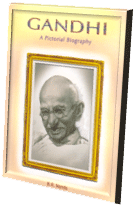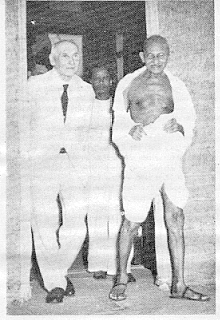
P.O. SEVAGRAM, DIST.WARDHA 442102, MS, INDIA. Phone: 91-7152-284753
FOUNDED BY MAHATMA GANDHI IN 1936
BIOGRAPHY OF GANDHI
GANDHI - A PICTORIAL BIOGRAPHY
by Shri B. R. Nanda

GANDHI
- A PICTORIAL BIOGRAPHY
Shri B. R. Nanda
Table of Contents
- About Gandhi
- Childhood
- Off To England
- Briefless Barrister
- In The 'Dark Continent'
- The Young Politician
- Satyagraha Struggle In South Africa
- The Making Of The Mahatma
- Return To India
- Gandhi's Ashram
- World War I
- Rowlatt Bills
- Nonviolent Non-cooperation
- Arrest And Imprisonment
- Reaction And Recovery
- Declaration Of Complete Independence
- Gandhi-Irwin Pact
- Round Table Conference
- In London
- Resumption Of Struggle
- Campaign Against Untouchability
- A New Deal For The Village
- The New Constitution
- Hindu-Muslim Antagonism
- Nonviolence In A Violent World
- Cripps Mission
- "Quit India"
- Simla Conference
- Cabinet Mission
- Communal Conflagration
- Partition of India
- Mission of Peace
- The End
- Gandhi and Nonviolence
About This Book
This is the first pictorial biography of Gandhi in which the narrative-concise, readable and incisive is illustrated with contemporary photographs and facsimiles of letters, newspaper reports and cartoons, adding up to a fascinating flash-back on the life of Mahatma Gandhi and the struggle for Indian freedom led by him. There is a skilful matching in this book of text and illustrations, of description and analysis and of concrete detail and large perspective. This pictorial biography will revive many memories in those who have lived through the Gandhian era; it should also be of interest to the post-independence generation.
About Author
Shri B. R. Nanda - former Director, Nehru Memorial Museum and Library, New Delhi. His full-scale biography of Mahatma Gandhi has been published in India, Britain and the U.S.A. and translated into French, Spanish, Italian and several other languages
Chapter-28 : Cabinet Mission

Early in 1946, the Labour Government dispatched an all-party parliamentary delegation to India to meet Indian leaders and convince them of the British desire for an early settlement of the Indian constitutional issue. However, it was only in March 1946 that with the arrival of three Cabinet Ministers, Lord Pethick-Lawrence, Sir Stafford Cripps and Mr. A. V. Alexander, a crucial stage was reached in the negotiations between the British Government and the Indian political parties. The negotiations were conducted on behalf of the Congress by Abul Kalam Azad who was assisted by Nehru and Patel. Gandhi was, however, frequently consulted. The negotiations were bogged down on the basic question whether India was to remain united or to be split up to satisfy the Muslim League's demand for Pakistan. The Congress opposed to the partition of the country, but was prepared to go to the farthest limit in conceding cultural, economic and regional autonomy to various regions. A conference at Simla failed to resolve the Congress-League differences. The Cabinet Mission then offered a compromise plan in their statement of May 16,1946. They sketched a three-tier constitutional structure for India. On the top was to be a Union of India embracing British India as well as the Indian States, but dealing only with foreign affairs, defence and communications. The bottom tier was to consist of Provinces and States in which were to vest all residuary powers. The intermediate tier was to comprise "groups" to be formed by Provinces (if they chose) to deal with certain common subjects. The Muslim League avowed its acceptance of the Cabinet Mission Plan, but this acceptance was more apparent than real, The League and its leaders made no secret of their hope and design that the new constitution would be used to effect a partition of the country. "Let me tell you," Jinnah told the Muslim League Council on June 5, 1946 "that Muslim India will not rest content until we have established full, complete and sovereign Pakistan." It was this apparent contradiction in the League's stand, which made Gandhi and his colleagues in the Congress uneasy about the "grouping of provinces", which the League wanted to make compulsory and a stepping-stone to Pakistan. The controversy on this issue wrecked the Cabinet Mission Plan.
The three-tier constitution was a delicate mechanism with numerous checks and balances. Without the fullest cooperation between the major parties it was impossible to draft a new constitution, much less to work it. This cooperation was, however, lacking. The Cabinet Mission Plan was a compromise but it did not really bring the two parties together. The result was that questions presumed to have been settled by the Cabinet Mission were reopened soon after the return of its three members to England. Controversy rose to a fever pitch on two crucial issues, that of the "grouping" of provinces and the composition of the "interim government".